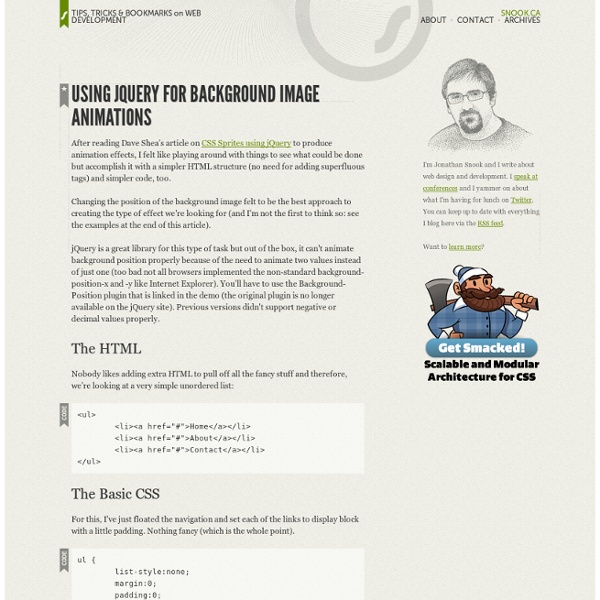jQuery Backstretch by Scott Robbin
Advertisement a simple jQuery plugin that allows you to add a dynamically-resized, slideshow-capable background image to any page or element by Scott Robbin Download Backstretch Now link to a hosted copy on cdnjs.com or download the entire project, including examples. Do you see the full-sized background image on this page? Images are fetched after your page is loaded, so your users won't have to wait for the (often large) image to download before using your site. Demos Where can I get it? If you are interested in learning more about Backstretch, it's recommended that you view the project on GitHub. Support Basic support is offered through Github's issues tracker. If you are in need of immediate support, Email Support is available for $17. Other jQuery Plugins If you like this plugin, feel free to check out some of the others I've built. Intelligist Share and demo code in-page, usingGitHub gists.
Slideshow 2! A javascript class for Mootools 1.2 to stream and animate the presentation of images on your website
If you are looking to download Slideshow, or for class documentation, please visit the open-source project at Google Code. If you are looking for the old version of Slideshow, it has been moved here. Support If you find this page helpful, why not donate? Because donations are voluntary, the act of making a small contribution has a big effect towards promoting future development and support. Examples By popular request, the following are some simplified examples of Slideshow usage: Demos Click below to view the various demos - perhaps the most impressive effect of all is simply viewing this page with javascript turned off. Slideshow 2! Colophon All photos were taken with a trusty Canon DigitalElph in New York, October 2007.
jquery-tubular - a jQuery plugin for full-size YouTube video backgrounds
demo: seanmccambridge.com/tubular Usage is straightforward and requires JavaScript on the client's browser to work. Tubular is a jQuery plugin and therefore relies on jQuery. You will need to know the YouTube ID of the video you want to use as well as the container DIV of your web page. Please note, tubular must be deployed on a web server to function. 1. jQuery must appear BEFORE tubular in your HTML document. 2. 3. That's it! Please note that tubular will change the structure of your CSS.
Navigation Menus: Trends and Examples | Design Showcase
Advertisement Navigation is the most significant element in web design. Since web-layouts don’t have any physical representation a user can stick to, consistent navigation menu is one of the few design elements which provide users with some sense of orientation and guide them through the site. Users should be able to rely on it which is why designers shouldn’t mess around with it. That’s why in most cases it’s where simple, intuitive and conventional solutions are usually the best option. This article presents recent trends, examples and innovative solutions for design of modern navigation menus. 1. The most significant task a navigation menu has to fulfill is to unambiguously guide the visitors through the different sections of the site. This navigation scheme can be used not only for the horizontal navigation; it can can be applied to vertical navigation as well. 2. In any case over the last months a number of web-sites integrated Mac-styled-navigation in their web-sites. 3. 4. 5. 6.
Backstretch: a simple jQuery plugin that allows you to add a dynamically-resized background image to any page
Advertisement a simple jQuery plugin that allows you to add a dynamically-resized, slideshow-capable background image to any page or element by Scott Robbin Download Backstretch Now link to a hosted copy on cdnjs.com or download the entire project, including examples. Do you see the full-sized background image on this page? In a nutshell, that's what Backstretch does. Images are fetched after your page is loaded, so your users won't have to wait for the (often large) image to download before using your site. Demos Where can I get it? If you are interested in learning more about Backstretch, it's recommended that you view the project on GitHub. Support Basic support is offered through Github's issues tracker. If you are in need of immediate support, Email Support is available for $17. Other jQuery Plugins If you like this plugin, feel free to check out some of the others I've built. Intelligist Share and demo code in-page, usingGitHub gists.
How to Create Coda(tm) like Scrolling Window using Mootools -2 « N Rao Lakkakula’s Blog
As I promised earlier , here is the code to do it. Look at the Final Output with some other Mootools Goodies at my website ( Assuming our html file is index.html and we have two folders names ‘js’ and ‘css’ to keep javascript and css files respectively. Step 1: Write HTML File ( I tookoff DOCTYPE and other header stuff to make it simple) index.html Step 2 : Write Javascript to do Scroll Effect js/site.js $(‘nav_about’).addEvent(‘click’, function(event) { event = new Event(event).stop(); scroll.toElement(‘content_about’); }); $(‘nav_projects’).addEvent(‘click’, function(event) { event = new Event(event).stop(); scroll.toElement(‘content_projects’); }); $(‘nav_portfolio’).addEvent(‘click’, function(event) { event = new Event(event).stop(); scroll.toElement(‘content_portfolio’); }); $(‘nav_blog’).addEvent(‘click’, function(event) { event = new Event(event).stop(); scroll.toElement(‘content_blog’); }); }); Step 3 : Stylesheets css/site.css css/h.css Thats It! css/v.css Like this:



